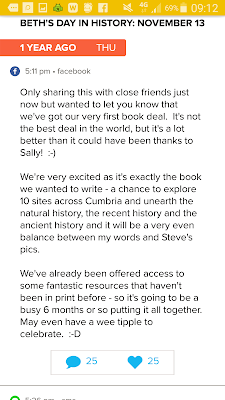 |
| Kentmere Valley |
We got involved when we approached the museum with a view to taking some pictures of the boat for our book. Naturally there was a charge involved but as we were writing the book on a shoestring we came up with a more creative solution - we asked if they'd allow us to use the photos in exchange for a promise to raise the money needed to date the boat - thankfully they trusted us enough to agree.
Below is the press release from the museum - please take a moment to read it and, next time you're in Kendal, pop along to visit them and see the boat. In an era of tightening budgets when more and more museums are coming under threat (this happened in Lancashire just this week) we really MUST support them in any way we can. Kendal Museum is one of the oldest museums in the country and has a superb array of artefacts from the Egyptians to the local Vikings - it's a fantastic place to visit and something the town should all be really proud of.
Kendal Museums ‘Viking Boat’
A
wooden dugout boat was found in 1959 in the bed of Kentmere Tarn by Mr Leslie
Ridding, operator of the drag
line excavator at the Cape
Asbestos Company diatomite
works. It was donated to Kendal Museum by the
landowner and after many years in store it is now on public display. Another boat was found four years earlier in
1955 (by the same workman) and it is believed to date from c.1300-1320. The earlier
boat went for conservation at the National Maritime Museum and is now housed at
the Windermere Jetty Museum.
Due to the dating of the first boat it was always thought
that the Kendal Museum boat was earlier as it was found deeper, and is of a
more basic type. It has always been called the ‘Viking’ boat but has never been
scientifically dated……until now.
 |
| VIKING boat (Pic taken from our Historic Cumbria book) |
Wanda
Lewcun, a student on the Kendal Museum Diploma in Cultural Heritage Course last
year, and now a volunteer, wanted to pursue the dating of the boat as a project. Oxford Archaeology North were contacted and
they came to examine the boat in June 2015 and a small fragment was removed for
analysis. Denise Druce, the Environmental
Archaeology Specialist from OAN found it to be Ash which is only suitable for radiocarbon
dating, so it was sent to the Scottish Universities
Environmental Research Centre for radiocarbon dating. The costs for the project were raised through
crowdfunding organised by the author Beth Pipe on her blog –
‘Cumbrian Rambler’,
and through private donations.
When
the results came back they showed that there is a 95.4%
probability that the boat is late 10th to mid-12th century, and is most likely
to be pre-Norman conquest. Morag Clement, Archaeology Curator said “It
is very exciting to finally have a date for the boat that links it to the Late
Viking Period. It really is the Kendal
Museum Viking Boat. This date also
proves that the boat is several hundred years earlier than the first boat discovered
in Kentmere Tarn.”
Fifty five years after its discovery it is on display and
accompanies a handful of other Viking age objects that survive from the Kendal
area.
PS If you want to buy our book, which covers 10 sites across Cumbria including Kentmere, then click here.










